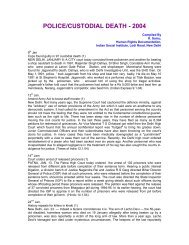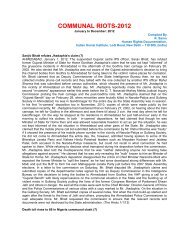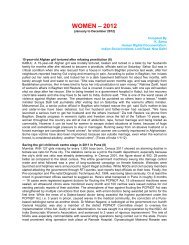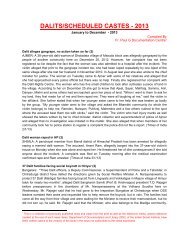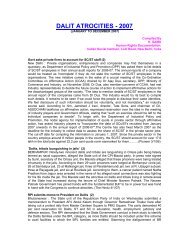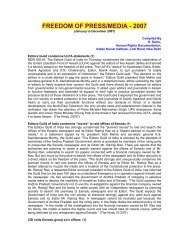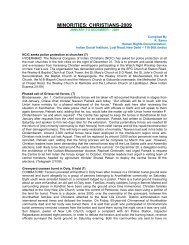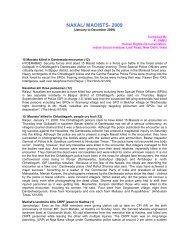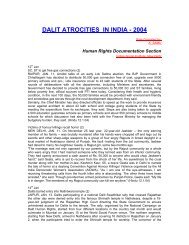TRIBALS - 2012 - Indian Social Institute
TRIBALS - 2012 - Indian Social Institute
TRIBALS - 2012 - Indian Social Institute
You also want an ePaper? Increase the reach of your titles
YUMPU automatically turns print PDFs into web optimized ePapers that Google loves.
to the Maoists, who, too, are reportedly on a recruitment drive in the area to rejuvenate their disintegrating<br />
outfit. And the government has reasons to be optimistic, as not only tribal men but also tribal women have<br />
responded and submitted applications for the posts of junior police constables in large numbers. The<br />
government records reveal that 13,000 tribal women from the three districts of West Midnapore, Bankura<br />
and Purulia have submitted applications for the post of junior constables. Currently, physical tests are<br />
going on for recruitment of the first batch of tribal youths from the LWE region in the special police force<br />
out of a sanctioned strength of 5,000, and another 5,000 as national volunteer force is underway.<br />
According to official records, in 28 police stations across Bankura, West Midnapore and Purulia districts,<br />
93,285 tribal men and women have submitted forms for the the post of special police constable. The<br />
government in its notification issued in September announced that 5,000 youths will be recruited as<br />
special police constables. “This is a great achievement for the state government. This recruitment drive<br />
has led several tribal youths to withdraw their support from the CPI-Maoists. We have also received forms<br />
from several relatives of Maoists squad members and leaders,” said a police official. Police sources said<br />
three brothers of Maoists squad leader Jayanta, former chief of Goaltore squad Sidhu Soren’s brother<br />
Sagen Baskey submitted application forms to West Midnapore police. Ishwar Kaibartya, brother of Karan<br />
Kaibartya alias Sanjai, a squad leader of Purulia, has also applied for the job for a constable. (<strong>Indian</strong><br />
Express 2/1/12)<br />
Woman killed in firing by forest personnel (6)<br />
Agartala: A tribal woman was killed and another injured on Monday when Forest Protection Force<br />
personnel opened fire at Ratrangi, a remote tribal hamlet in South Tripura district, about 75 km from here,<br />
police sources said. A group of tribals tried to prevent two tribal youths from being arrested for cutting<br />
down trees by attacking the personnel,who opened fire leaving a woman dead and another injured, the<br />
sources said. The injured was admitted to hospital. (Zee News 2/1/12)<br />
Tribals bear the brunt of Maoist violence as well as Government Operations (6)<br />
Raipur, Jan 3 : Humanity, harmony, good governance are ideals a democratic nation aspires to. As the<br />
world''s largest democracy, India is no exception. Her lawmakers and administrators, often the brightest of<br />
her citizens, vow to serve the people and govern them with integrity. These lofty ideals, however, hold no<br />
ground in the face of the harsh pressures of conflict, now spreading rapidly across the country. I searched<br />
for and interviewed every single individual of a village during my sojourns in the Bastar region of<br />
Chhattisgarh. I was looking for signs of optimism, revival, hope; in a region that has faced years, nay,<br />
decades, of strife. I returned empty-handed. The tales of misery are all too common. Some of them come<br />
to light when a ''milestone'' is achieved, such as when Koteshwar ''Kishenji'' Rao was killed in November<br />
2011, making the entire nation sit up and take notice. The fear evoked by the killing of this top gun of<br />
Communist Party of India (Maoist) became evident when guerrilla forces gathered together and pledged<br />
revenge against the State. The impact of the alert and call for revenge, reflected in escalation in violence,<br />
is limited to those who never were involved in any manner in the first place: the hapless tribes of the Red<br />
Corridor, mute spectators bearing the brunt of the bullet from both sides. Like everything else, here too,<br />
history bears repeating. Many cases were registered over time; some were even written about; but none<br />
of this came near to reflecting the real picture of the remote Maoist affected villages of India. Regions,<br />
which barely merit acknowledgement and simply don''t exist for most of us, leave alone considering the<br />
plight of its dwellers. The isolated village in Bastar, like most of its hamlets, is situated amid lush green<br />
Sal forests. As one walks on the muddy path of the remarkably picturesque village, long before the huts<br />
become visible, a vast expanse of paddy fields lends a sense of prosperity. Imagining this sort of richness<br />
in a Maoist region, it turns out, is surreal. This standing crop, unable to breathe in the suffocated air, has<br />
been standing long, awaiting a human touch. There is none. In such places, where even a thud has the<br />
potential to scare one to death, it is not difficult to imagine how terrifying it would be to see five






